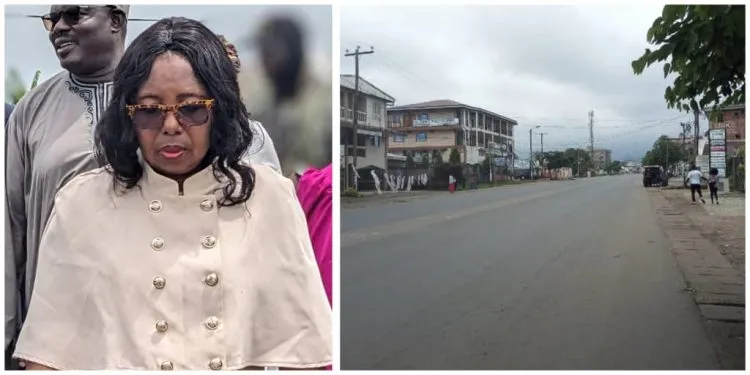By Tata Mbunwe
Secondary Education Minister Nalova Lyonga, also an indigene of Buea, has raised alarm over the deteriorating state of roads in the South Western Regional capital, urging stakeholders to address the issue without delay.
Roads in Buea, notably the national road number 8, which is the only road linking the city to other towns, has been in a deplorable state. It is inundated with potholes and lacks road signs.
During her address at the launch of the Open Business Days for technical and vocational schools in Buea on March 14, Minister Nalova spared no words in highlighting the dire condition of the Buea’s road network.
Expressing her dismay, Minister Nalova lamented the pervasive degradation plaguing roads leading into and within the city of Buea.
She said the road infrastructure did not reflect the Buea she knew and called on authorities in charge to take responsibility.
“The roads in Buea are something else. You cannot talk about it,” she lamented.
She was surprised at the apparent inaction by local authorities and government agencies responsible for road construction and maintenance and underscored the need for coordinated efforts to address the problem.
“Those roads are not roads for human beings. That is not how Buea was. Why do we want Buea to be like that? You know, if a school is a school, let the school grow in a place which is humane; in a place where you have human beings,” she added.
Minister Nalova’s remarks aligned with the reality commuters face navigating the city’s primary entry and exit road, the national road number 8, which connects Buea to Mutengene, Limbe, and Kumba.
The vital thoroughfare now resembles a patchwork of potholes, posing significant challenges to motorists and pedestrians alike.
Despite efforts by the Buea Council, led by Mayor David Mafany Namange, to address the city’s infrastructural deficiencies, progress has been hindered by administrative constraints.
The Mayor lamented during a Council session last year that repair works on degraded sections of national road number 8 fall outside the prerogative of the local Council, as the responsibility lies with the Ministry of Public Works.
In response to the prevailing inertia, Minister Nalova called for a collaborative approach and shared responsibility of both authorities and citizens in ensuring the upkeep of Buea’s road network.
“We are all sitting down and looking. You know, who will do the problem? Who will solve the problem tomorrow? It is not the government. We shall try and we shall try to get the government in. It’s important that we should do that and everybody should talk to every government member who is attached or identified with this project. Let them do what they need to do. And we shall do what we need to do,” she urged.
She added: “The government cannot do everything. The elites cannot do everything. But there is something that you can do on your own and there is something that the government can do on its own. That we call order. There has to be order. So we have to plan.”
Buea isn’t the only town in Cameroon grappling with bad roads. Poor road infrastructure is more of a national problem, with many of the country’s national, regional and divisional roads in poor conditions.
Aside from being narrow, the roads are ridden with potholes, lack road signs and are littered with exploitative military/police control points.
This year, the government launched several road projects across the nation, including the long-awaited Kumba-Mundemba road, a section of the national road number 16, which stretches from Loum in the Littoral Region, to Mundemba, through Kumba and Mbonge in the South West Region.
Other roads such as the Bamenda-Babadjou road linking the North West to the West Region as well as the Bamenda Ring Road are under construction.
However, the national road number 8 that links Buea to other cities is not on the government’s plan, despite its deplorable state.



